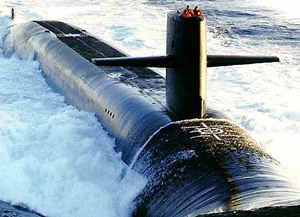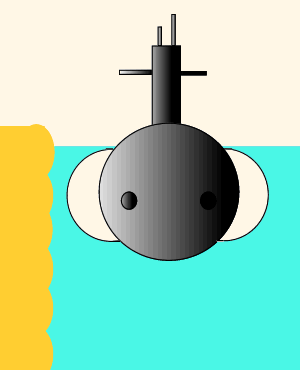Science of Conflict
Buoyant force
When an object is placed in a fluid a force, called the buoyant force, acts to push the object upwards. The strength of the force is equal to the weight of the volume of fluid displaced by the object.
It is the objects volume, not
its weight that determines the buoyant force.
Take a submarine, for example, the buoyant force acts to push it to the
surface while the weight of the submarine acts to push it to the bottom.
The strength of these two opposing forces determines if the sub rises
or sinks in the water.

A submarine however, can only control its weight, since the buoyant force can only be adjusted by a change in volume. This is unlikely to happen since the hull is inflexible and designed to withstand high water pressure that would crush it at great depths.
A submarine sinks if it takes in water to increase its weight (force acting
downward). It will rise if it expells water from its tanks, therefore
making itself lighter.
As it rises, the buoyant force is greater than the force acting to push
it down (weight).
As it sinks the force pushing it down (weight) is greater than the buoyant
force pushing it up.

1) How can a submerged submarine increase the buoyant force acting on it?
2) Is this practical? Explain.
3) How can a submarine, floating on the surface, increase the buoyant force acting on it?
4) How does a submarine use its ballast tanks to sink or float to the surface?
5) The ballast tanks are used to increase the buoyant force acting on t with chemicalhe submarine
6) When submerging with its engines off submarine can adjust its
7) The buoyant force acting on a fully submerged submarine is
Click to go to the next question.